Effect of waterlogging duration on germination, physiological characteristics, and yield of mungbean (Vigna radiata L.)
The study was conducted to evaluate the germination, physiological
responses, yield-related traits, and seed yield of three mungbean
varieties, viz. DXVN7, DXVN5, and DX11, under waterlogging
coditions in the 2019 Summer. In experiment 1, the seeds of the three
mungbean varieties were immersed in distilled water in Petri dishes
for 12, 24, 36, 48, and 72h. Afterwards, water was removed and the
percentage of germinated seeds was calculated at 84h after sowing.
In experiment 2, plants were waterlogged at the seedling stage (25
days after germination) for 3, 6, and 9 days. Waterlogging depth was
maintained at 3cm above the soil surface. Physiological traits were
determined at the recovery period after termination of waterlogging
(45 days after germination). The results showed that waterlogging
significantly decreased germination percentages, plant height, root
dry weight, leaf relative water content (RWC), SPAD value, Fv/Fm
index, leaf photosynthesis, total dry weight, and seed yield of all
varieties. Germination percentages at 12 and 24h of waterlogging
were not significantly affected, whereas germination was
significantly reduced at up to 36h of waterlogging. Seventy-two
hours of waterlogging caused failure in germination. Nine days of
waterlogging at the seedling stage adversely affected the
physiological traits and seed yield of the mungbean varieties with
31% of yield reduction. Meanwhile, plants grew better at 3 days of
waterlogging. Among the three varieties, DXVN7 showed the best
adaptability under waterlogging conditions, attaining the highest seed
germination and yield.
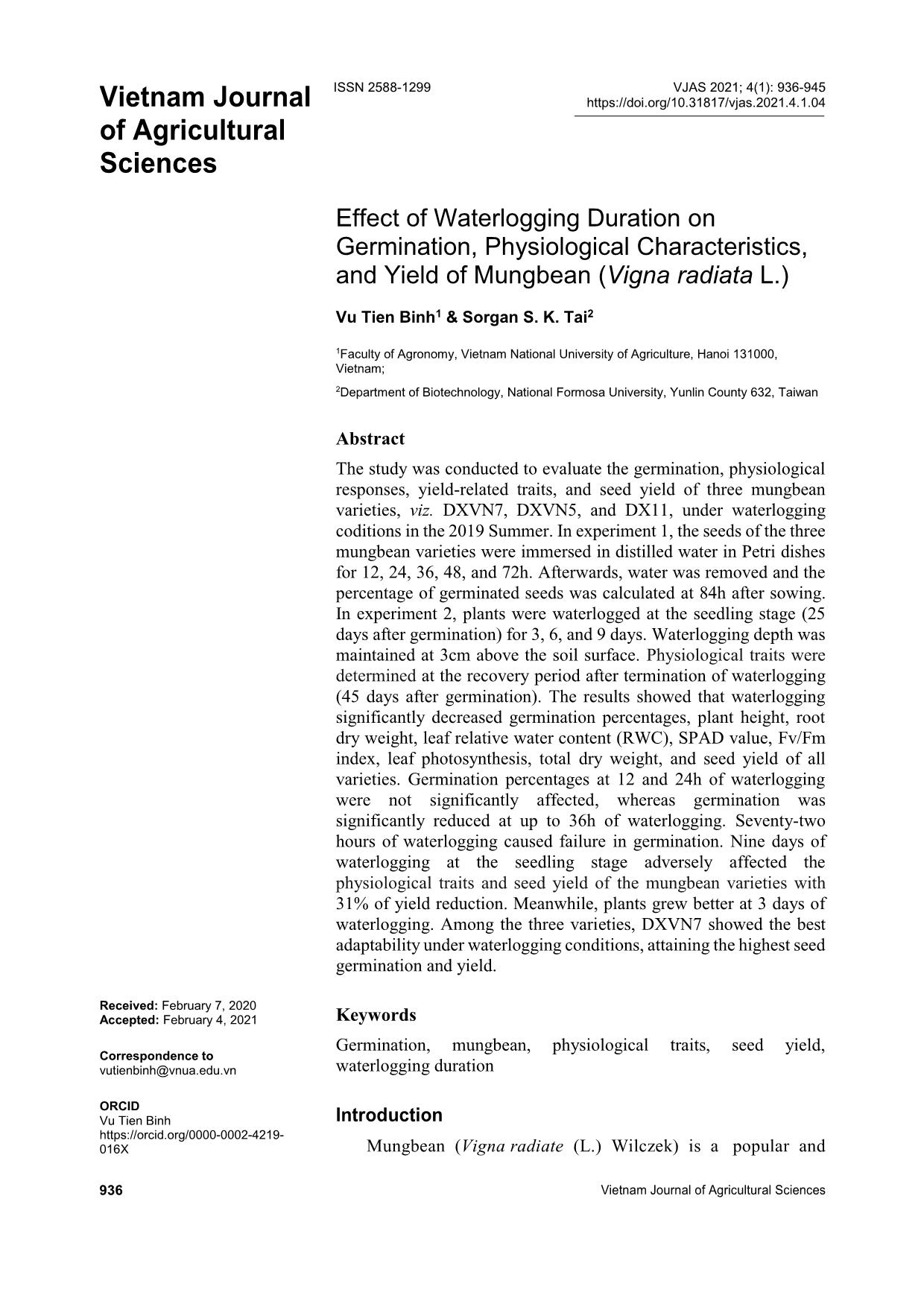
Trang 1
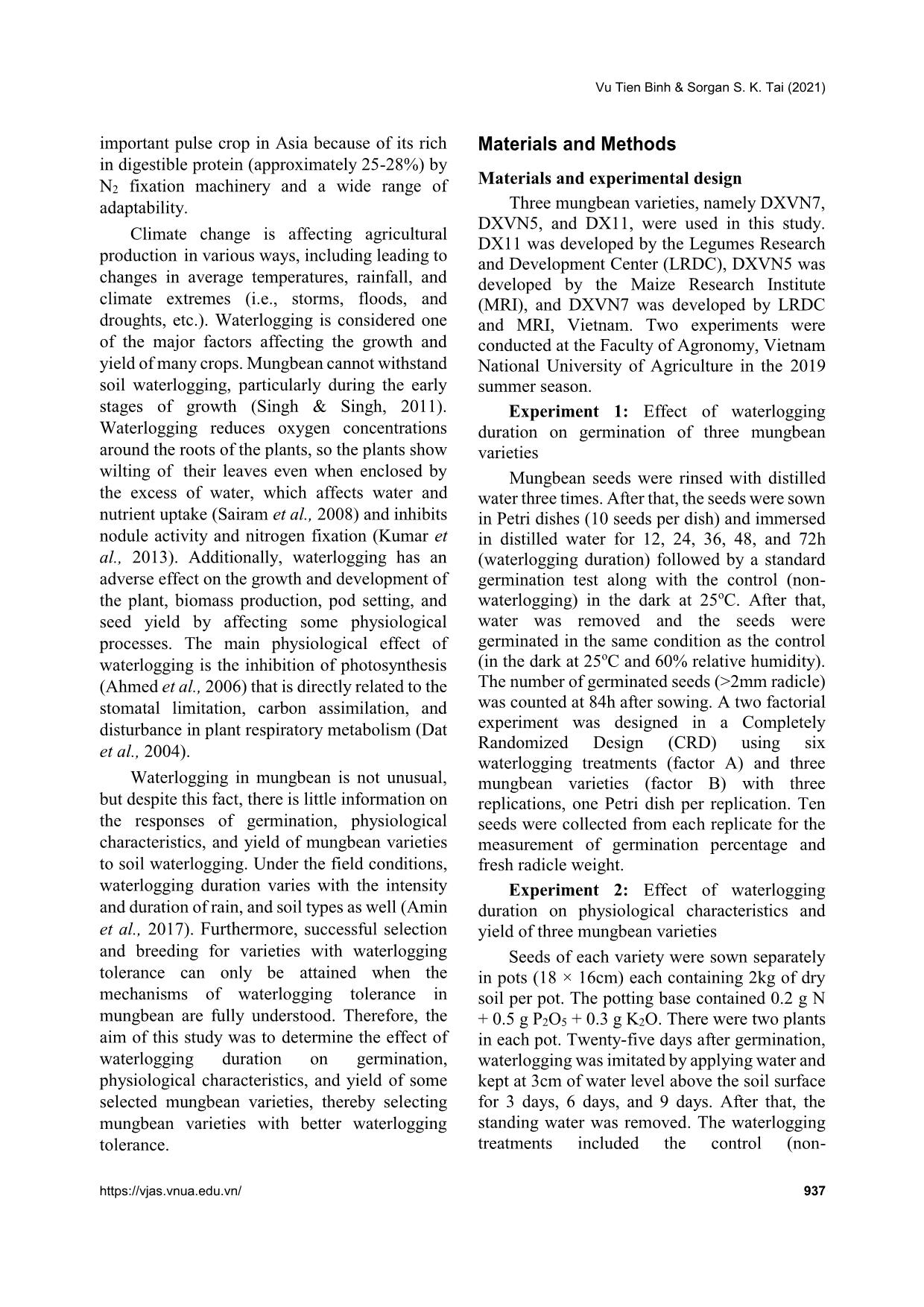
Trang 2
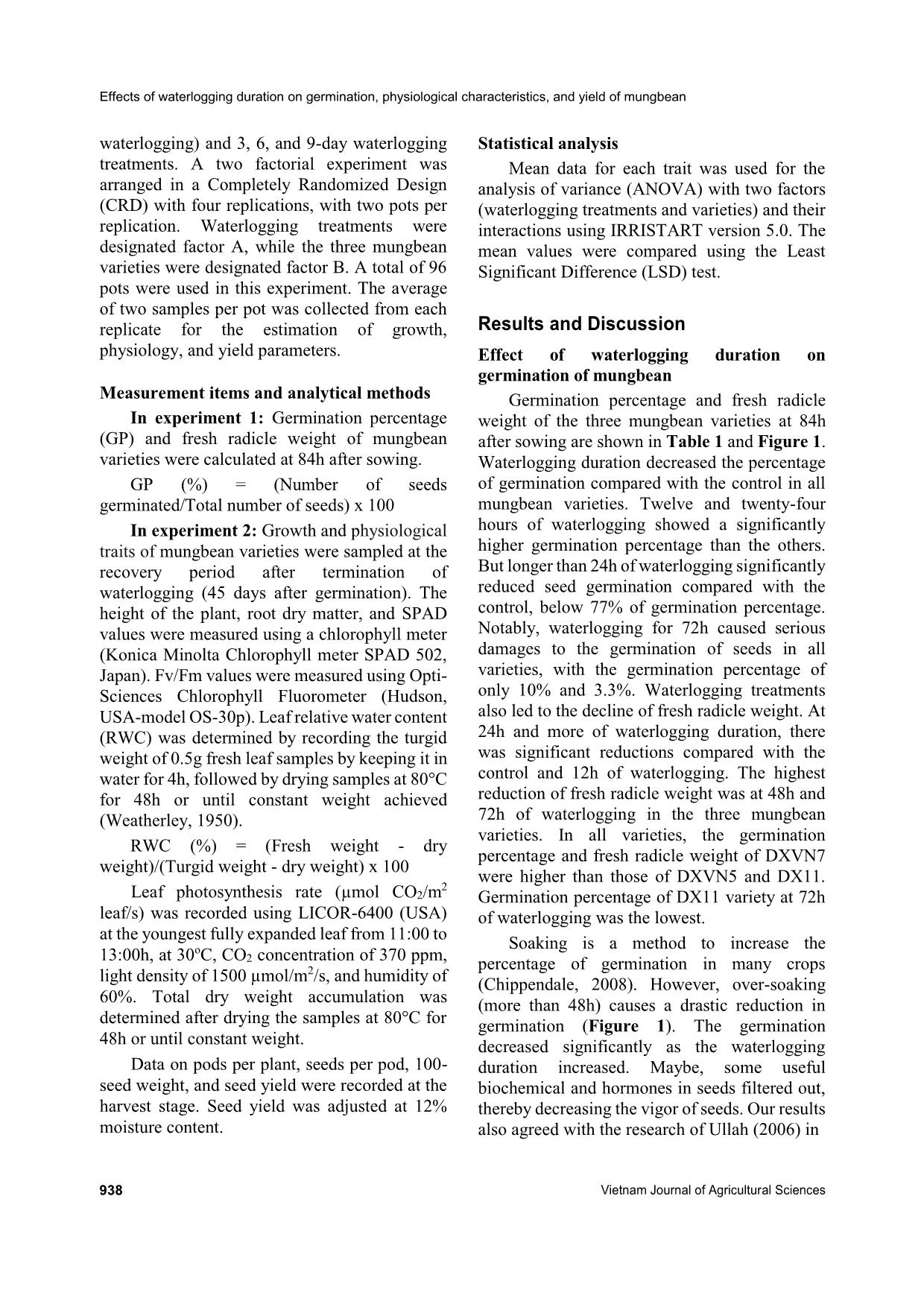
Trang 3
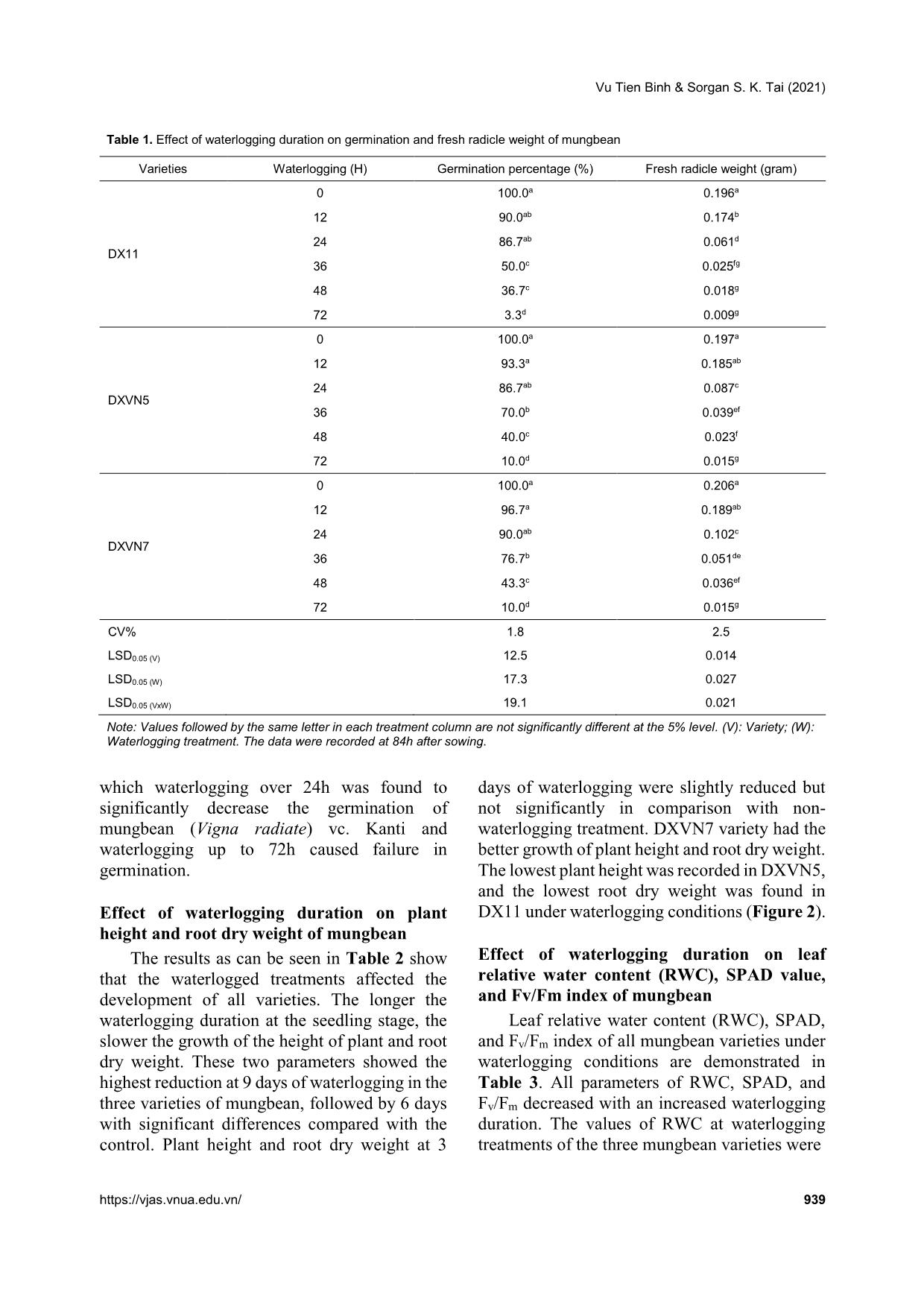
Trang 4
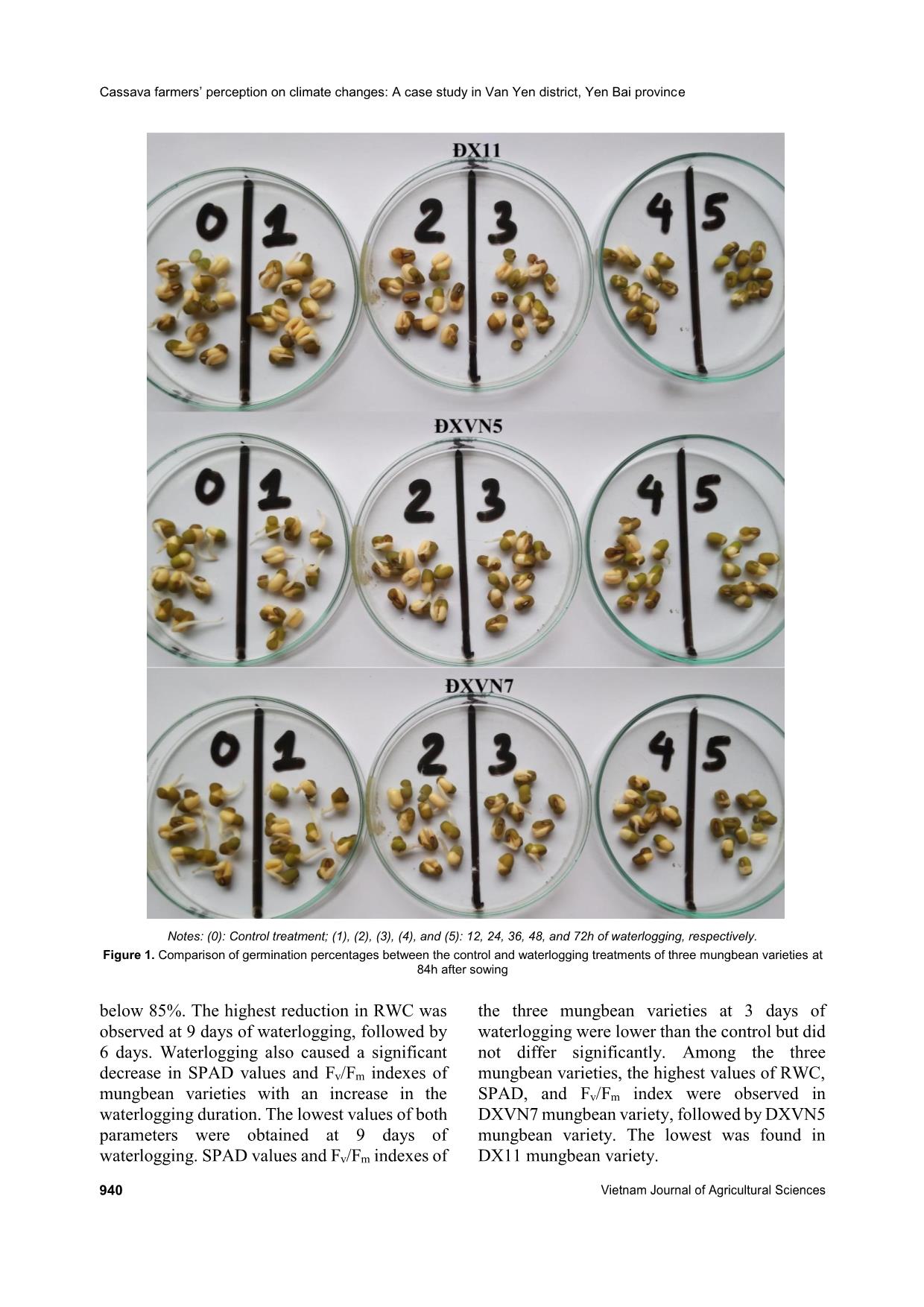
Trang 5
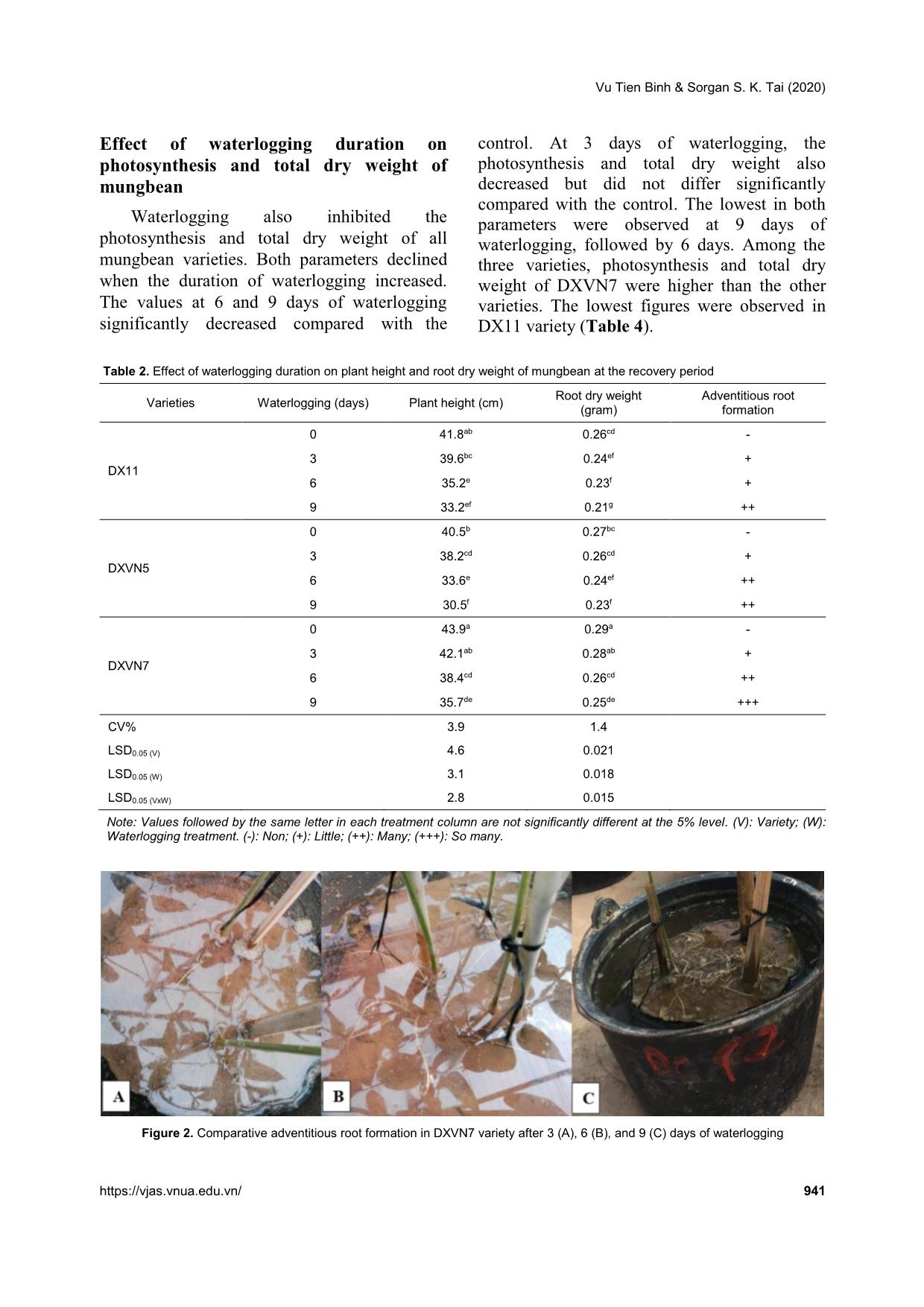
Trang 6
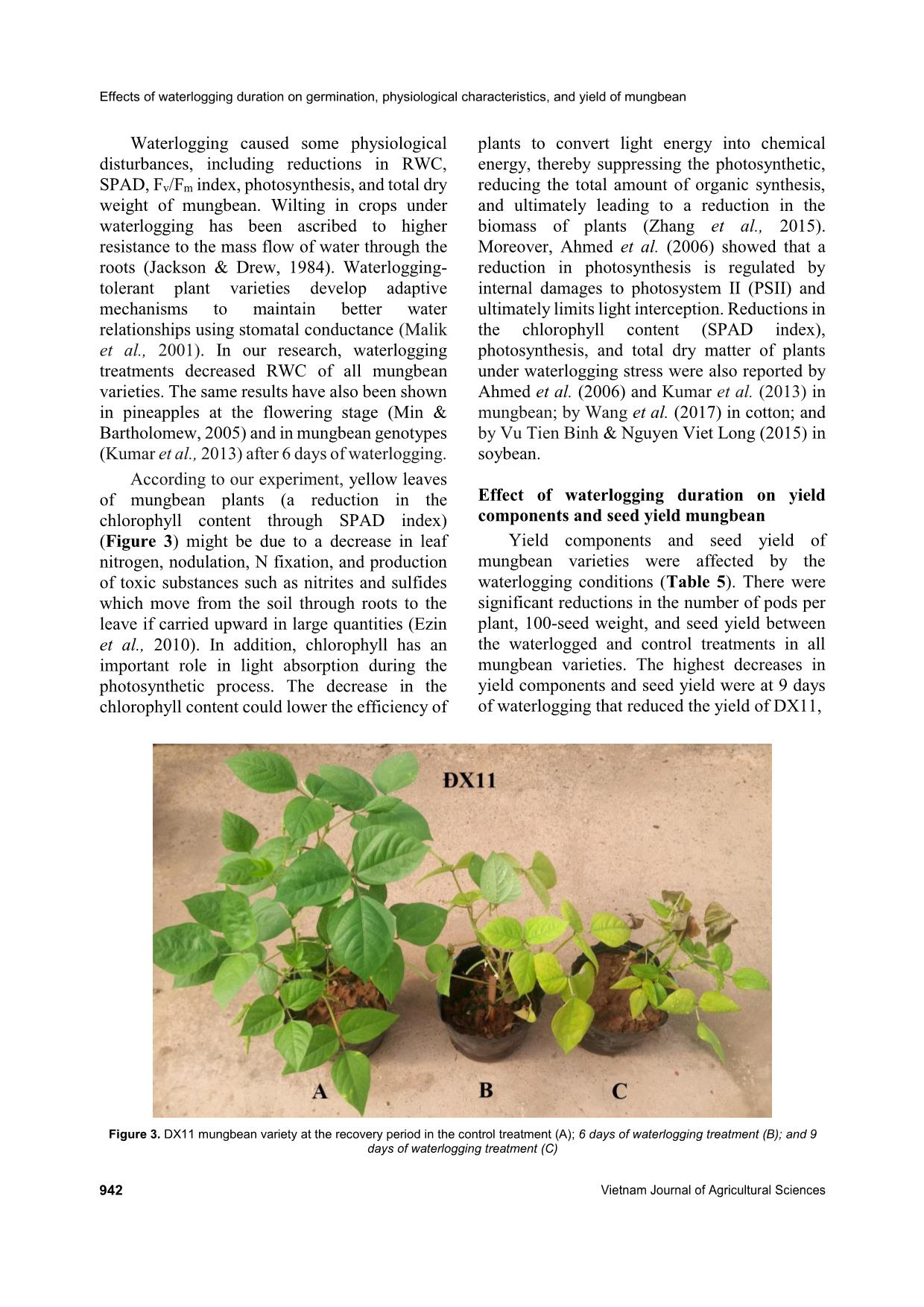
Trang 7
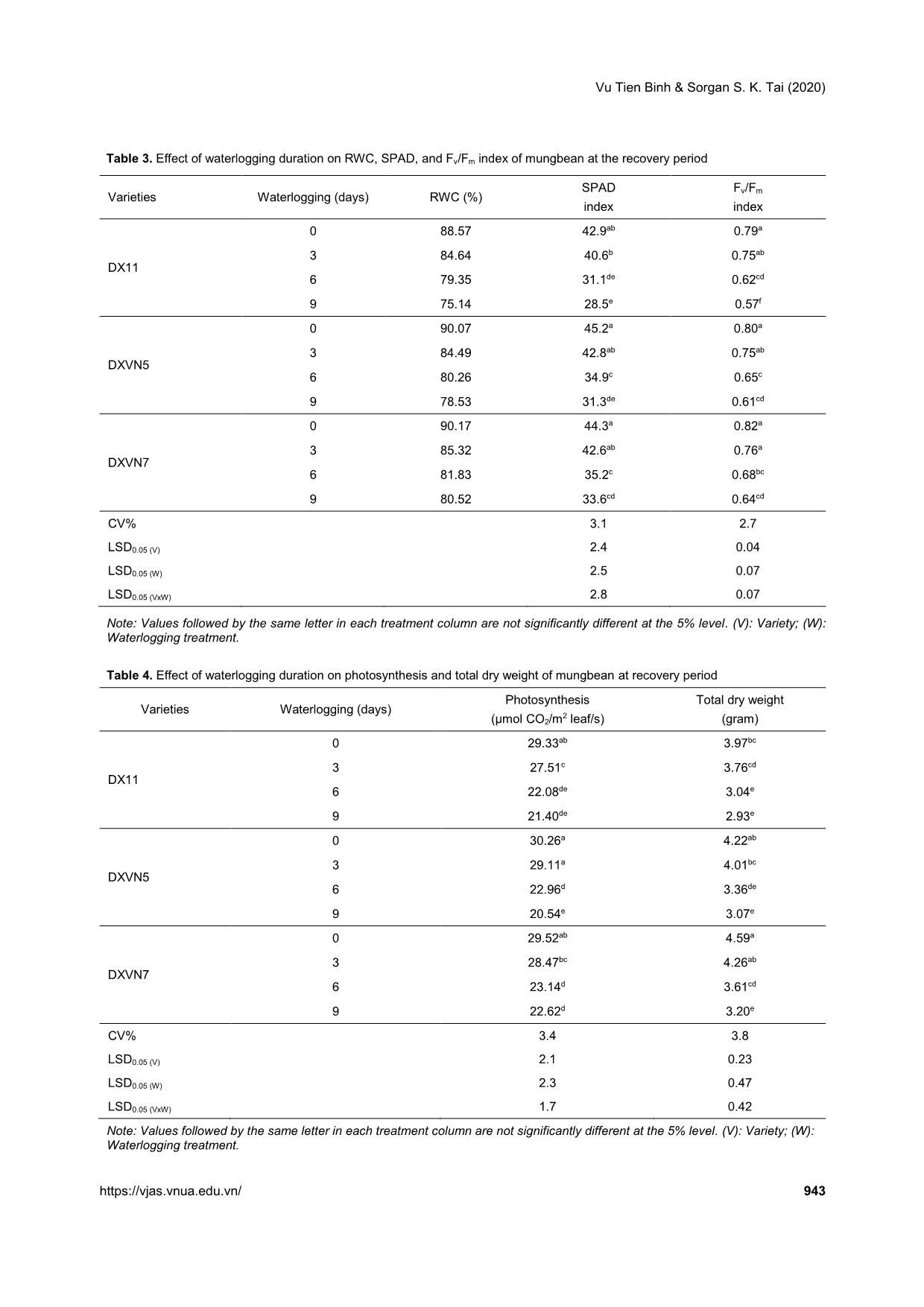
Trang 8
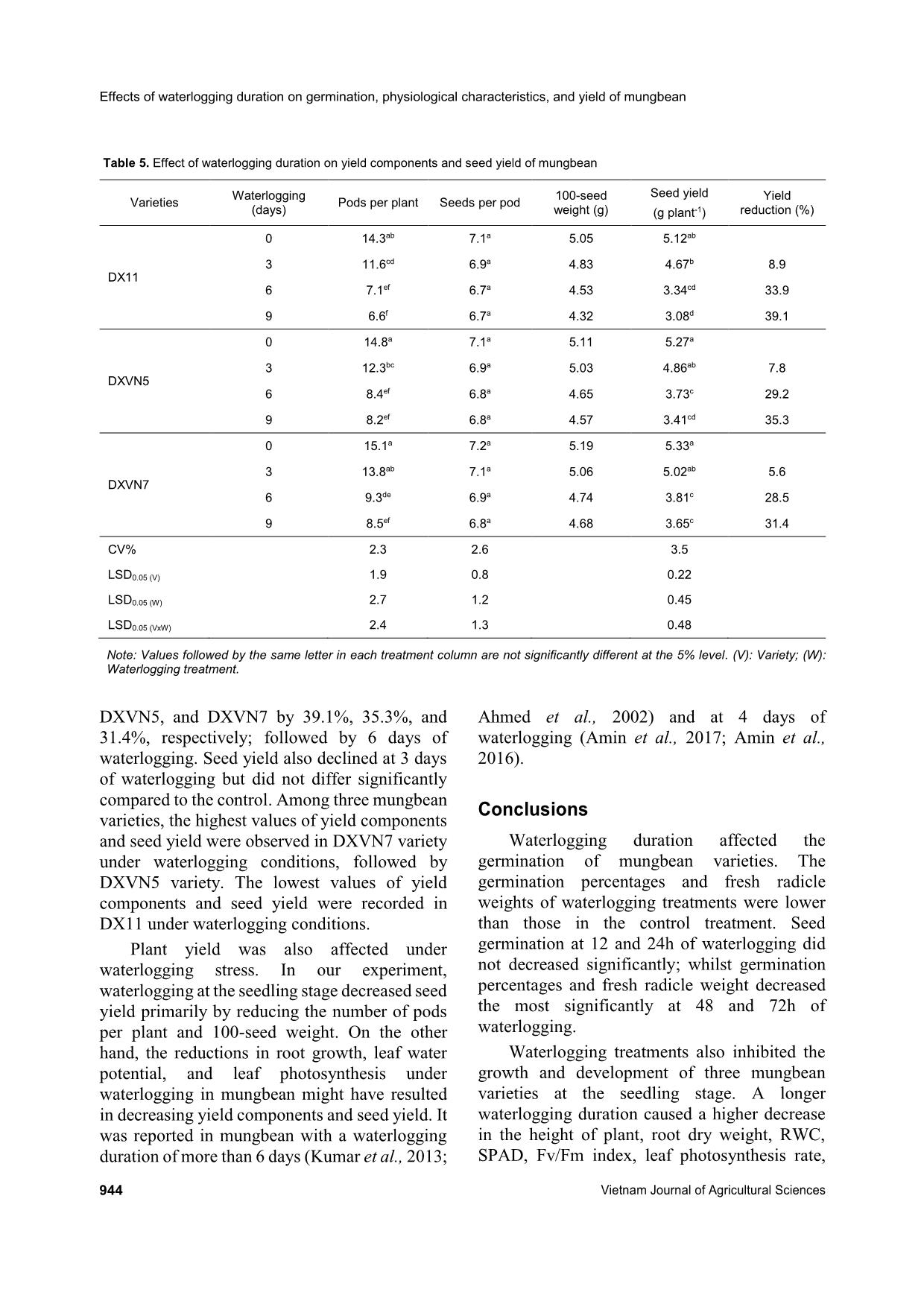
Trang 9
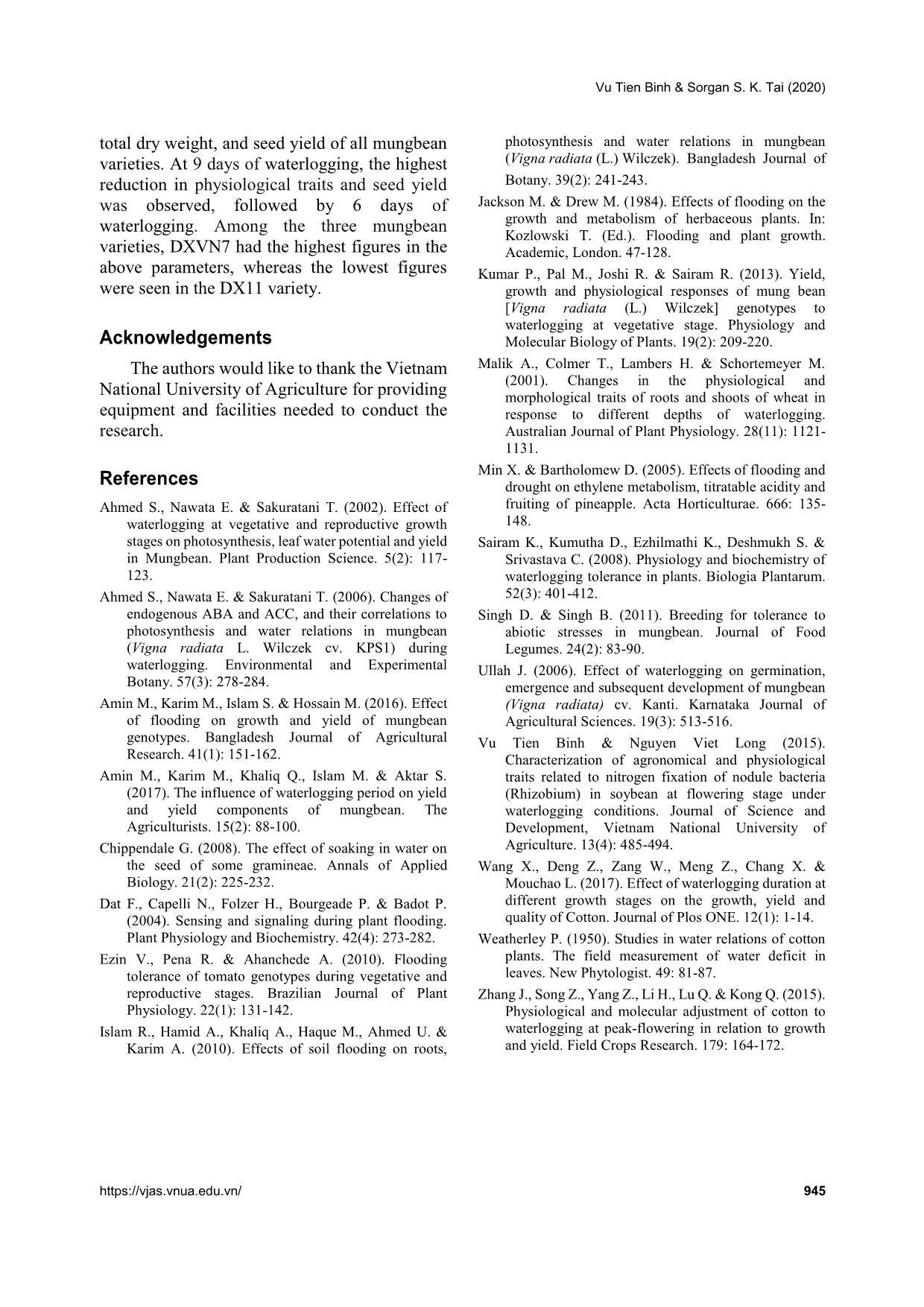
Trang 10
Tóm tắt nội dung tài liệu: Effect of waterlogging duration on germination, physiological characteristics, and yield of mungbean (Vigna radiata L.)
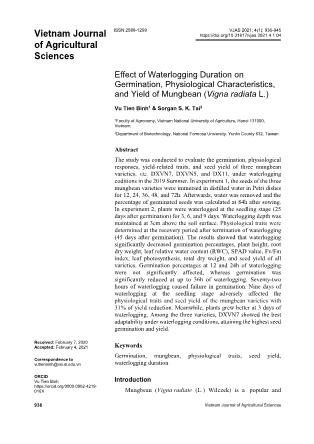
ntent (RWC), SPAD value, and Fv/Fm index of mungbean Leaf relative water content (RWC), SPAD, and Fv/Fm index of all mungbean varieties under waterlogging conditions are demonstrated in Table 3. All parameters of RWC, SPAD, and Fv/Fm decreased with an increased waterlogging duration. The values of RWC at waterlogging treatments of the three mungbean varieties were Cassava farmers’ perception on climate changes: A case study in Van Yen district, Yen Bai province 940 Vietnam Journal of Agricultural Sciences Notes: (0): Control treatment; (1), (2), (3), (4), and (5): 12, 24, 36, 48, and 72h of waterlogging, respectively. Figure 1. Comparison of germination percentages between the control and waterlogging treatments of three mungbean varieties at 84h after sowing below 85%. The highest reduction in RWC was observed at 9 days of waterlogging, followed by 6 days. Waterlogging also caused a significant decrease in SPAD values and Fv/Fm indexes of mungbean varieties with an increase in the waterlogging duration. The lowest values of both parameters were obtained at 9 days of waterlogging. SPAD values and Fv/Fm indexes of the three mungbean varieties at 3 days of waterlogging were lower than the control but did not differ significantly. Among the three mungbean varieties, the highest values of RWC, SPAD, and Fv/Fm index were observed in DXVN7 mungbean variety, followed by DXVN5 mungbean variety. The lowest was found in DX11 mungbean variety. Vu Tien Binh & Sorgan S. K. Tai (2020) https://vjas.vnua.edu.vn/ 941 Effect of waterlogging duration on photosynthesis and total dry weight of mungbean Waterlogging also inhibited the photosynthesis and total dry weight of all mungbean varieties. Both parameters declined when the duration of waterlogging increased. The values at 6 and 9 days of waterlogging significantly decreased compared with the control. At 3 days of waterlogging, the photosynthesis and total dry weight also decreased but did not differ significantly compared with the control. The lowest in both parameters were observed at 9 days of waterlogging, followed by 6 days. Among the three varieties, photosynthesis and total dry weight of DXVN7 were higher than the other varieties. The lowest figures were observed in DX11 variety (Table 4). Table 2. Effect of waterlogging duration on plant height and root dry weight of mungbean at the recovery period Varieties Waterlogging (days) Plant height (cm) Root dry weight (gram) Adventitious root formation DX11 0 41.8ab 0.26cd - 3 39.6bc 0.24ef + 6 35.2e 0.23f + 9 33.2ef 0.21g ++ DXVN5 0 40.5b 0.27bc - 3 38.2cd 0.26cd + 6 33.6e 0.24ef ++ 9 30.5f 0.23f ++ DXVN7 0 43.9a 0.29a - 3 42.1ab 0.28ab + 6 38.4cd 0.26cd ++ 9 35.7de 0.25de +++ CV% 3.9 1.4 LSD0.05 (V) 4.6 0.021 LSD0.05 (W) 3.1 0.018 LSD0.05 (VxW) 2.8 0.015 Note: Values followed by the same letter in each treatment column are not significantly different at the 5% level. (V): Variety; (W): Waterlogging treatment. (-): Non; (+): Little; (++): Many; (+++): So many. Figure 2. Comparative adventitious root formation in DXVN7 variety after 3 (A), 6 (B), and 9 (C) days of waterlogging Effects of waterlogging duration on germination, physiological characteristics, and yield of mungbean 942 Vietnam Journal of Agricultural Sciences Waterlogging caused some physiological disturbances, including reductions in RWC, SPAD, Fv/Fm index, photosynthesis, and total dry weight of mungbean. Wilting in crops under waterlogging has been ascribed to higher resistance to the mass flow of water through the roots (Jackson & Drew, 1984). Waterlogging- tolerant plant varieties develop adaptive mechanisms to maintain better water relationships using stomatal conductance (Malik et al., 2001). In our research, waterlogging treatments decreased RWC of all mungbean varieties. The same results have also been shown in pineapples at the flowering stage (Min & Bartholomew, 2005) and in mungbean genotypes (Kumar et al., 2013) after 6 days of waterlogging. According to our experiment, yellow leaves of mungbean plants (a reduction in the chlorophyll content through SPAD index) (Figure 3) might be due to a decrease in leaf nitrogen, nodulation, N fixation, and production of toxic substances such as nitrites and sulfides which move from the soil through roots to the leave if carried upward in large quantities (Ezin et al., 2010). In addition, chlorophyll has an important role in light absorption during the photosynthetic process. The decrease in the chlorophyll content could lower the efficiency of plants to convert light energy into chemical energy, thereby suppressing the photosynthetic, reducing the total amount of organic synthesis, and ultimately leading to a reduction in the biomass of plants (Zhang et al., 2015). Moreover, Ahmed et al. (2006) showed that a reduction in photosynthesis is regulated by internal damages to photosystem II (PSII) and ultimately limits light interception. Reductions in the chlorophyll content (SPAD index), photosynthesis, and total dry matter of plants under waterlogging stress were also reported by Ahmed et al. (2006) and Kumar et al. (2013) in mungbean; by Wang et al. (2017) in cotton; and by Vu Tien Binh & Nguyen Viet Long (2015) in soybean. Effect of waterlogging duration on yield components and seed yield mungbean Yield components and seed yield of mungbean varieties were affected by the waterlogging conditions (Table 5). There were significant reductions in the number of pods per plant, 100-seed weight, and seed yield between the waterlogged and control treatments in all mungbean varieties. The highest decreases in yield components and seed yield were at 9 days of waterlogging that reduced the yield of DX11, Figure 3. DX11 mungbean variety at the recovery period in the control treatment (A); 6 days of waterlogging treatment (B); and 9 days of waterlogging treatment (C) Vu Tien Binh & Sorgan S. K. Tai (2020) https://vjas.vnua.edu.vn/ 943 Table 3. Effect of waterlogging duration on RWC, SPAD, and Fv/Fm index of mungbean at the recovery period Varieties Waterlogging (days) RWC (%) SPAD index Fv/Fm index DX11 0 88.57 42.9ab 0.79a 3 84.64 40.6b 0.75ab 6 79.35 31.1de 0.62cd 9 75.14 28.5e 0.57f DXVN5 0 90.07 45.2a 0.80a 3 84.49 42.8ab 0.75ab 6 80.26 34.9c 0.65c 9 78.53 31.3de 0.61cd DXVN7 0 90.17 44.3a 0.82a 3 85.32 42.6ab 0.76a 6 81.83 35.2c 0.68bc 9 80.52 33.6cd 0.64cd CV% 3.1 2.7 LSD0.05 (V) 2.4 0.04 LSD0.05 (W) 2.5 0.07 LSD0.05 (VxW) 2.8 0.07 Note: Values followed by the same letter in each treatment column are not significantly different at the 5% level. (V): Variety; (W): Waterlogging treatment. Table 4. Effect of waterlogging duration on photosynthesis and total dry weight of mungbean at recovery period Varieties Waterlogging (days) Photosynthesis (µmol CO2/m 2 leaf/s) Total dry weight (gram) DX11 0 29.33ab 3.97bc 3 27.51c 3.76cd 6 22.08de 3.04e 9 21.40de 2.93e DXVN5 0 30.26a 4.22ab 3 29.11a 4.01bc 6 22.96d 3.36de 9 20.54e 3.07e DXVN7 0 29.52ab 4.59a 3 28.47bc 4.26ab 6 23.14d 3.61cd 9 22.62d 3.20e CV% 3.4 3.8 LSD0.05 (V) 2.1 0.23 LSD0.05 (W) 2.3 0.47 LSD0.05 (VxW) 1.7 0.42 Note: Values followed by the same letter in each treatment column are not significantly different at the 5% level. (V): Variety; (W): Waterlogging treatment. Effects of waterlogging duration on germination, physiological characteristics, and yield of mungbean 944 Vietnam Journal of Agricultural Sciences Table 5. Effect of waterlogging duration on yield components and seed yield of mungbean Varieties Waterlogging (days) Pods per plant Seeds per pod 100-seed weight (g) Seed yield (g plant-1) Yield reduction (%) DX11 0 14.3ab 7.1a 5.05 5.12ab 3 11.6cd 6.9a 4.83 4.67b 8.9 6 7.1ef 6.7a 4.53 3.34cd 33.9 9 6.6f 6.7a 4.32 3.08d 39.1 DXVN5 0 14.8a 7.1a 5.11 5.27a 3 12.3bc 6.9a 5.03 4.86ab 7.8 6 8.4ef 6.8a 4.65 3.73c 29.2 9 8.2ef 6.8a 4.57 3.41cd 35.3 DXVN7 0 15.1a 7.2a 5.19 5.33a 3 13.8ab 7.1a 5.06 5.02ab 5.6 6 9.3de 6.9a 4.74 3.81c 28.5 9 8.5ef 6.8a 4.68 3.65c 31.4 CV% 2.3 2.6 3.5 LSD0.05 (V) 1.9 0.8 0.22 LSD0.05 (W) 2.7 1.2 0.45 LSD0.05 (VxW) 2.4 1.3 0.48 Note: Values followed by the same letter in each treatment column are not significantly different at the 5% level. (V): Variety; (W): Waterlogging treatment. DXVN5, and DXVN7 by 39.1%, 35.3%, and 31.4%, respectively; followed by 6 days of waterlogging. Seed yield also declined at 3 days of waterlogging but did not differ significantly compared to the control. Among three mungbean varieties, the highest values of yield components and seed yield were observed in DXVN7 variety under waterlogging conditions, followed by DXVN5 variety. The lowest values of yield components and seed yield were recorded in DX11 under waterlogging conditions. Plant yield was also affected under waterlogging stress. In our experiment, waterlogging at the seedling stage decreased seed yield primarily by reducing the number of pods per plant and 100-seed weight. On the other hand, the reductions in root growth, leaf water potential, and leaf photosynthesis under waterlogging in mungbean might have resulted in decreasing yield components and seed yield. It was reported in mungbean with a waterlogging duration of more than 6 days (Kumar et al., 2013; Ahmed et al., 2002) and at 4 days of waterlogging (Amin et al., 2017; Amin et al., 2016). Conclusions Waterlogging duration affected the germination of mungbean varieties. The germination percentages and fresh radicle weights of waterlogging treatments were lower than those in the control treatment. Seed germination at 12 and 24h of waterlogging did not decreased significantly; whilst germination percentages and fresh radicle weight decreased the most significantly at 48 and 72h of waterlogging. Waterlogging treatments also inhibited the growth and development of three mungbean varieties at the seedling stage. A longer waterlogging duration caused a higher decrease in the height of plant, root dry weight, RWC, SPAD, Fv/Fm index, leaf photosynthesis rate, Vu Tien Binh & Sorgan S. K. Tai (2020) https://vjas.vnua.edu.vn/ 945 total dry weight, and seed yield of all mungbean varieties. At 9 days of waterlogging, the highest reduction in physiological traits and seed yield was observed, followed by 6 days of waterlogging. Among the three mungbean varieties, DXVN7 had the highest figures in the above parameters, whereas the lowest figures were seen in the DX11 variety. Acknowledgements The authors would like to thank the Vietnam National University of Agriculture for providing equipment and facilities needed to conduct the research. References Ahmed S., Nawata E. & Sakuratani T. (2002). Effect of waterlogging at vegetative and reproductive growth stages on photosynthesis, leaf water potential and yield in Mungbean. Plant Production Science. 5(2): 117- 123. Ahmed S., Nawata E. & Sakuratani T. (2006). Changes of endogenous ABA and ACC, and their correlations to photosynthesis and water relations in mungbean (Vigna radiata L. Wilczek cv. KPS1) during waterlogging. Environmental and Experimental Botany. 57(3): 278-284. Amin M., Karim M., Islam S. & Hossain M. (2016). Effect of flooding on growth and yield of mungbean genotypes. Bangladesh Journal of Agricultural Research. 41(1): 151-162. Amin M., Karim M., Khaliq Q., Islam M. & Aktar S. (2017). The influence of waterlogging period on yield and yield components of mungbean. The Agriculturists. 15(2): 88-100. Chippendale G. (2008). The effect of soaking in water on the seed of some gramineae. Annals of Applied Biology. 21(2): 225-232. Dat F., Capelli N., Folzer H., Bourgeade P. & Badot P. (2004). Sensing and signaling during plant flooding. Plant Physiology and Biochemistry. 42(4): 273-282. Ezin V., Pena R. & Ahanchede A. (2010). Flooding tolerance of tomato genotypes during vegetative and reproductive stages. Brazilian Journal of Plant Physiology. 22(1): 131-142. Islam R., Hamid A., Khaliq A., Haque M., Ahmed U. & Karim A. (2010). Effects of soil flooding on roots, photosynthesis and water relations in mungbean (Vigna radiata (L.) Wilczek). Bangladesh Journal of Botany. 39(2): 241-243. Jackson M. & Drew M. (1984). Effects of flooding on the growth and metabolism of herbaceous plants. In: Kozlowski T. (Ed.). Flooding and plant growth. Academic, London. 47-128. Kumar P., Pal M., Joshi R. & Sairam R. (2013). Yield, growth and physiological responses of mung bean [Vigna radiata (L.) Wilczek] genotypes to waterlogging at vegetative stage. Physiology and Molecular Biology of Plants. 19(2): 209-220. Malik A., Colmer T., Lambers H. & Schortemeyer M. (2001). Changes in the physiological and morphological traits of roots and shoots of wheat in response to different depths of waterlogging. Australian Journal of Plant Physiology. 28(11): 1121- 1131. Min X. & Bartholomew D. (2005). Effects of flooding and drought on ethylene metabolism, titratable acidity and fruiting of pineapple. Acta Horticulturae. 666: 135- 148. Sairam K., Kumutha D., Ezhilmathi K., Deshmukh S. & Srivastava C. (2008). Physiology and biochemistry of waterlogging tolerance in plants. Biologia Plantarum. 52(3): 401-412. Singh D. & Singh B. (2011). Breeding for tolerance to abiotic stresses in mungbean. Journal of Food Legumes. 24(2): 83-90. Ullah J. (2006). Effect of waterlogging on germination, emergence and subsequent development of mungbean (Vigna radiata) cv. Kanti. Karnataka Journal of Agricultural Sciences. 19(3): 513-516. Vu Tien Binh & Nguyen Viet Long (2015). Characterization of agronomical and physiological traits related to nitrogen fixation of nodule bacteria (Rhizobium) in soybean at flowering stage under waterlogging conditions. Journal of Science and Development, Vietnam National University of Agriculture. 13(4): 485-494. Wang X., Deng Z., Zang W., Meng Z., Chang X. & Mouchao L. (2017). Effect of waterlogging duration at different growth stages on the growth, yield and quality of Cotton. Journal of Plos ONE. 12(1): 1-14. Weatherley P. (1950). Studies in water relations of cotton plants. The field measurement of water deficit in leaves. New Phytologist. 49: 81-87. Zhang J., Song Z., Yang Z., Li H., Lu Q. & Kong Q. (2015). Physiological and molecular adjustment of cotton to waterlogging at peak-flowering in relation to growth and yield. Field Crops Research. 179: 164-172.
File đính kèm:
 effect_of_waterlogging_duration_on_germination_physiological.pdf
effect_of_waterlogging_duration_on_germination_physiological.pdf

